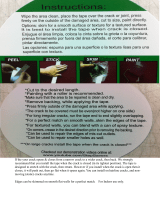
3
Care and Maintenance
Vinyl Windows and Patio Doors
BASIC INSPECTIONS AND MAINTENANCE – CONTINUED
SASH/PANEL INSPECTION
Inspect sash or patio door panel annually (monthly for coastal
areas). If the window has a removable sash, it may be helpful to
remove it before inspection.
• Inspect optional opening control devices for proper operation.
Contact us if not operating properly.
• Inspect stiles and rails for damage (cracks or splits in vinyl
surfaces).
• Check glass for cracks. If cracked, call your local glass supplier
for replacement.
• For insulating glass units, look for moisture or fogging
between glass panes (most likely to occur on cold mornings).
This may be an indication of seal failure. Call us for
recommendations.
WEATHERSTRIP
Inspecting and maintaining weatherstrip can help avoid costly
structural damage from water leakage and energy loss due to air
and/or water inltration. Replace weatherstrip that is missing,
torn, cracked, brittle, discolored, gummy, or that has no “bounce
back” when pressed down. Call us for replacement instructions.
Precautions
• We recommend denatured alcohol for non water-soluble
cleaning. Lacquer thinner may be used in small amounts,
but only as directed. Thoroughly rinse any vinyl surfaces that
come into contact with lacquer thinner. Other solvents such as
mineral spirits or petroleum-based products may damage or
dissolve weatherstrip.
• When using alcohol, always test small area rst to avoid
product damage.
• Do not use anything sharp near weatherstrip.
Light Cleaning
1. Clean with damp cloth or mild soap and water.
2. Rinse and dry thoroughly.
3. Repeat if necessary.
Non Water-Soluble Cleaning
Clean with denatured alcohol on soft cloth. If denatured alcohol
doesn’t work:
1. Clean with small amount lacquer thinner on soft cloth.
2. Repeat if necessary.
3. Clean with mild soap and water, then rinse. If unsuccessful,
consider replacing weatherstrip.
Repair
If weatherstrip is loose or falling out of the kerf:
1. Carefully remove weatherstrip.
2. Apply thin bead of silicone sealant into kerf.
3. Reinstall weatherstrip.
4. Hold in place with tape for 24 hours.
5. Carefully remove tape.
GUTTERS AND OVERHANGS
Gutters and overhangs protect windows and patio doors from
excess water exposure. Clear at least once per year.
WEEP SYSTEM
Vinyl windows and patio doors
are not subject to moisture
damage; however, damage could
develop in the structure around
the unit if water does not drain
properly from the sill area to the
exterior.
Interior weep holes are usually
a rectangular or round hole cut
in the vinyl in the bottom of the sill track or in the face of a vertical
member of the sill near the bottom. Weep holes may be covered by
a sill insert or roller track. Access to these weep holes may require
removal of the sash or panel and then removal of the snapped in
sill insert or roller track. Sash/panel removal can be awkward, see
the appropriate product guide at www.jeld-wen.com/resources for
safety recommendations and the proper procedure for removing the
sash or panel.
Exterior weep holes are usually a
round or rectangular hole cut in
the exterior face of the vinyl sill.
These may have a small ap or
bafe covering the hole.
1. Regularly clean sill track with
vacuum or wipe thoroughly
with damp cloth. Thoroughly
remove any blockage in
the corners and from the
exterior weep holes caused by
caulking, masonry or stucco products or a piece of trim.
2. Pour small amount of water (1 cup) into interior sill track. If
water does not drain quickly from the sill through the weep
system, insert a thin wire into weep hole to clear the blockage.
When clearing exterior weep holes, the passages through the
inside of the frame may be slightly offset to the left or right. Do
not insert the wire farther than necessary because the insulating
glass unit may be damaged. Call us if unsure. Repeat until
water runs clear to the exterior. If not successful, call a service
technician.
EXTERIOR SIDING JOINT
A proper seal of the joint between the window and the exterior
surface of the structure will keep water and/or air from leaking
into the house. Inspect the sealant joint for:
• Cracks
• Voids
• Deteriorating areas (e.g. loss of adhesion)
Repair damaged sealant with a best quality sealant.
Note! Do not apply sealant to areas where installer or contractor
did not originally seal. Seek professional advice from an installer
or contractor if unsure.
When repairing a sealant joint, 100% silicone sealant is the most
durable, but it cannot be painted. Use 100% polyurethane sealant
if painted. Follow sealant manufacturer’s instructions for proper
application.
Bottom weep hole
Inside face weep hole
Exterior
weep holes
Interior sill track










